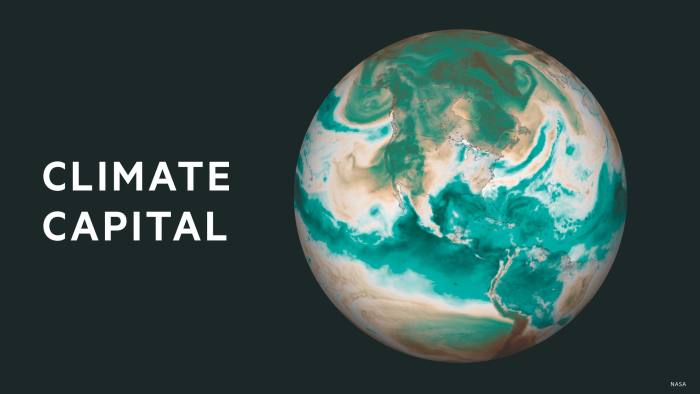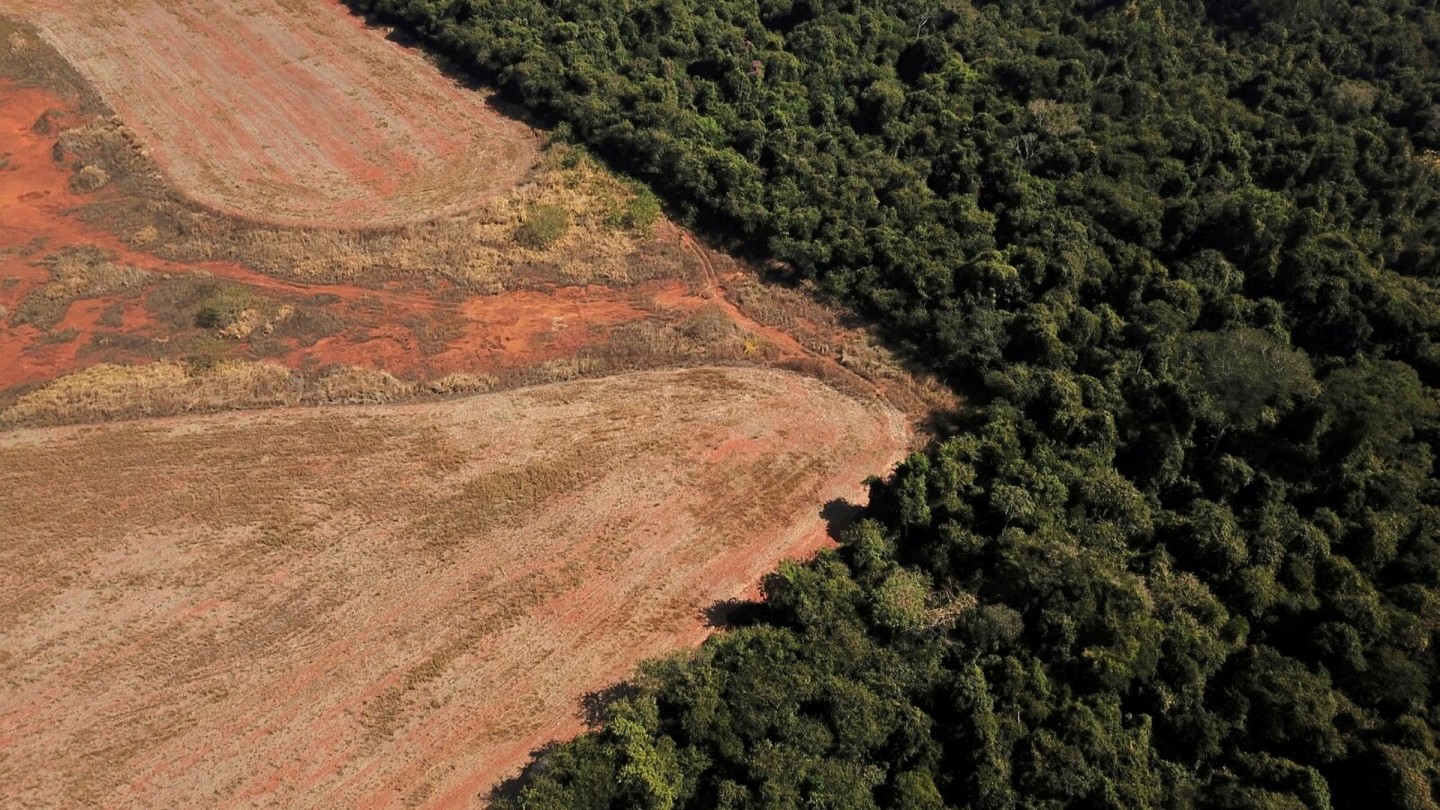
Sprinkler heads dangle from a suspended pipeline that stretches for several hundred metres, producing a fine mist that falls on row after row of green shoots. The irrigation system slowly turns on wheels around one of 36 perfect circles where, depending on the season, grow soy, cotton, beans, millet, sorghum or wheat.
With its scale and mechanisation, the enormous farm in Brazil is a paragon of modern crop production. All in the heart of South America’s largest tropical savannah, which was largely empty for much of the country’s history.
“Brazilian agriculture has completely changed in the past 20 years,” says Celestino Zanella, whose family founded the Grupo Decisão estate in the west of Bahia state in 2003. “When all this was overgrown, I said: ‘I have an opportunity’.”
Deep within the country’s interior, the conversion of huge swaths of a region known as the Cerrado into pasture and arable land over the past few decades has helped transform Brazil into an agrarian powerhouse.
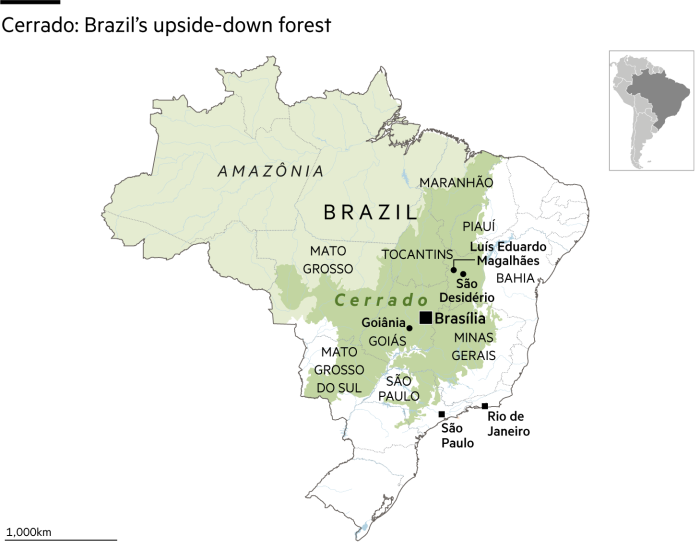
Once considered largely inhospitable, the region covering almost a quarter of the country is now one of the world’s breadbaskets, home to some of the biggest farms on the planet. Its cotton, corn and beef are shipped overseas by international commodities trading groups.
Most important of all are soyabeans, crushed for animal feed and oil. On the back of rising Chinese appetite for meat, Brazil has become the world’s number one soy producer, with about half its output — which has almost doubled over the past 10 years — coming from the Cerrado.
But the extent of the agricultural encroachment on to this vast patchwork of grasslands, scrub, wetlands and wooded areas is alarming ecologists. A rise in land clearances and wildfires has sparked warnings from scientists about the ecosystem’s role in combating global warming. They also fear the impact on its rich wildlife and importance as a water source, feeding eight of Brazil’s 12 basins.
Although it contains less dense foliage and canopy cover than the much larger Amazon rainforest to its north and west, the Cerrado is often called an “upside-down forest” because of the deep roots of its plants. Along with capturing water, they provide a significant carbon dioxide “sink” that helps fend off planetary heating. Tearing up trees, bushes and roots releases the gas.
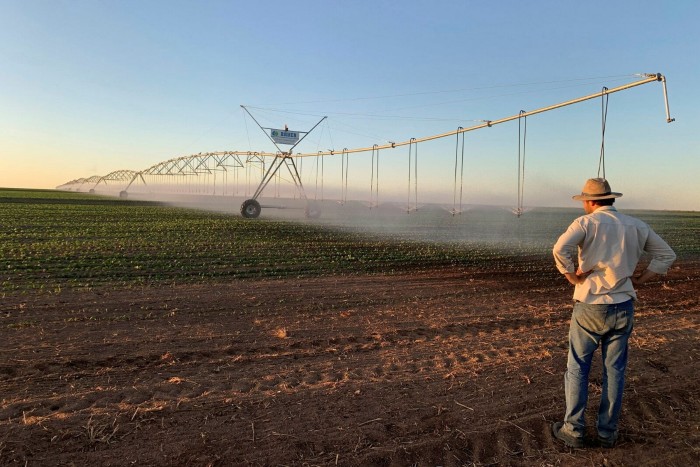
“If deforestation in the Cerrado continues at this rate, it will lose its historic role of carbon absorption and storage,” says Jean Ometto, an agronomist at Brazil’s National Institute for Space Research (Inpe). “It becomes more vulnerable. In practice, it means that it can lose biodiversity.”
The arguments around the Cerrado are more nuanced than those over the Amazon, where deforestation is often the result of illegal logging, wildcat miners and cattle ranching.
Most activists and experts do not question the case for agricultural development in the Cerrado. But some are asking if the farming boom has now gone too far and threatens the region’s unique ecological role.
The global food crisis provoked by the war in Ukraine has sharpened this tension, creating an extra incentive to expand planting in countries such as Brazil.
Long a cause for environmentalists, the Cerrado question is now on the radar of European supermarkets and retailers keen to provide consumers with food not linked to deforestation or land degradation.
“Deforestation of the Cerrado contributes to the emissions that generate greenhouse gases and aggravate climate change,” explains Mercedes Bustamante, a biologist and professor at the University of Brasília.
Satellite data from Inpe shows that 8,531 sq km was levelled in the 12 months to July 2021 — more than five times the size of Greater London. It was an 8 per cent jump to a six-year high.
Although the overall scale of clearances remains well below levels witnessed during the early 2000s, “this advance is more serious because there is less Cerrado standing”, adds Bustamante.
Almost one-fifth of the Cerrado’s native vegetation was removed between 1985 and 2020, by which point grazing pastures occupied nearly a quarter of its 2mn sq km area, and agriculture some 13 per cent, according to environmental think-tank Mapbiomas.
A little more than half of the region’s original landscapes are still intact. “The situation in the Cerrado is critical,” says Yuri Salmona, director at the not-for-profit Instituto Cerrados, a conservation non-governmental organisation. “[It] deserves the same attention and admiration as the Amazon.”
‘Severely threatened’
There was little more than a petrol station in Luís Eduardo Magalhães 30 years ago. Today, the growing municipality of 90,000 people in western Bahia is an advertisement for the prosperity of Brazil’s agribusiness revolution.
The town is the unofficial centre of an agricultural frontier known as Matopiba. An acronym for the northeastern states it intersects — Maranhão, Tocantins, Piauí and Bahia — the region is home to the largest undisturbed remnants of the Cerrado, but also the highest concentration of clearances.
Migrants with farming knowledge and capital from southern states began to arrive in the 1980s. With the fertile valleys already cultivated, they bought cheap, overgrown land on immense plains. Acidic soils with poor nutrients have been turned into some of the most productive farmland on Earth, through the development of hardy seeds, application of fertilisers, irrigation and investments in machinery.
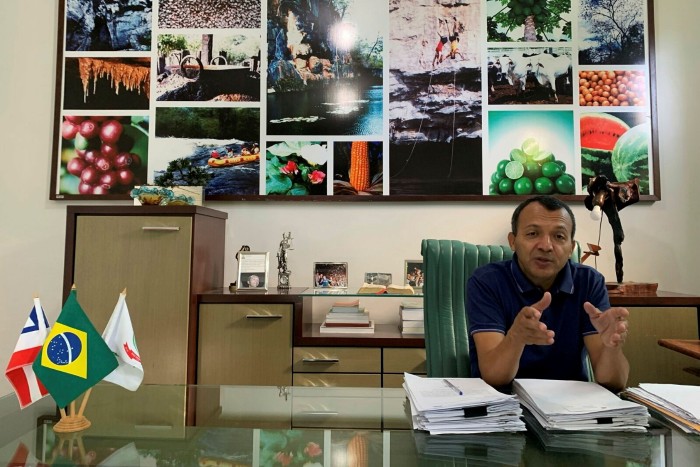
Odacil Ranzi was among the early pioneers, living in a tent for two years while he set up his farm. Now the president of the Association of Farmers and Irrigators of Bahia, he espouses a common view in the area that Brazilian agriculture is sustainable and environmentally sound.
“Farmers are very conscious about preservation. Today it is practically 90 per cent direct planting [without tillage], so there isn’t erosion because it’s protected,” he says. “In the Matopiba region, yes there is deforestation, but within the law.”
Any “suppression of native vegetation” — a technical term that covers clearances and deforestation — requires authorisation by public agencies, as does extracting water from rivers. Fazendeiros, large farm owners, say it is a rigorous process.
“We have the strictest forest code in the world,” says Ranzi. While the 2012 law forces private landholders in the Amazon to preserve 80 per cent of native vegetation, in the Cerrado it is just 20 per cent, rising to 35 per cent in the transition zone between the two regions.
A Mapbiomas study suggested that 98.4 per cent of land conversions in the Cerrado in 2021 had some kind of irregularity, such as lack of environmental licence, or overlap with an indigenous reserve or other protected area.
This, says Ane Alencar, director of science at non-profit group Ipam and a co-ordinator of MapBiomas, “seems to be the result of the feeling of impunity that has reigned in the country”, as a result of budget cuts at enforcement bodies and the relaxation of environmental laws.
Some ecologists say the quota for native vegetation is now insufficient to protect the savannah region. “The high fragmentation of the remaining landscape favours the extinction of endemic species in the region,” says Manuel Ferreira at the Federal University of Goiás.
The region shelters about 5 per cent of all the Earth’s biodiversity. But according to some scientists, there are already signs of strain on the Cerrado. A paper last year found the region was “becoming hotter and drier”. It said that intense daytime warming and a sudden drop in absolute humidity were “probably related to the massive conversion of Cerrado vegetation into croplands”.
Gabriel Hofmann, a researcher at Rio Grande do Sul Federal University, co-wrote the paper. He says regional climate changes here are more pronounced than those globally.
“The ecosystem could collapse due to these imbalances,” he adds. “It’s one of the main centres of biodiversity in the world that’s severely threatened at present, mainly through the expansion of the agricultural frontier.”
Another recent study into water resources in west Bahia concluded that streamflow in the Pratudão River had dropped by almost two-fifths in the three decades to 2018. “Our results indicate that agricultural changes rather than climate change may be the main driver,” it read.
Yet many fazendeiros and their supporters bristle at criticism over conservation, particularly from Europeans, who they accuse of hypocrisy given the continent long ago cut down most of its woodland.
They argue that Brazil’s habitat preservation is higher than in many developed countries, and question why they should sacrifice economic opportunities.
“What will people live off?” asks Zé Carlos, the mayor of São Desiderio. The municipality in western Bahia had the second-highest level of Cerrado clearances in 2021, according to Inpe data.
The local politician says his town offers opportunities thanks to activity associated with agribusiness, such as machinery vendors, restaurants and tyre shops. “We can’t let development stop,” he adds. “Even more so in a country like ours, where we still have a lot of poverty.”
Land disputes
Ednaldo Lopes Leite points at a sea of blooming white cotton flowers and says he and his family and neighbours used to pick wild fruits and graze cattle on this land. “The deforestation finished it,” says Lopes Leite, gazing at the vast arable fields abutting the wild Cerrado he can still access. “It’s all crops now.”
He is a geraizeiro: the name given to traditional communities who settled in isolated corners of western Bahia from the 19th century onwards, but typically without formal land titles.
The tracts now off-bounds to Lopes Leite’s family and neighbours lie on a megafarm complex called Agronegócio Condomínio Cachoeira do Estrondo, comprising more than a dozen landowners across 214,000 hectares in Formosa do Rio Preto municipality. The geraizeiros allege that since 2014 they have been subjected to harassment, intimidation and violence by private security forces.
For its part, the Estrondo estate said it had “suffered many criminal attacks over the years, from destruction of properties to harassment of employees and their families”.
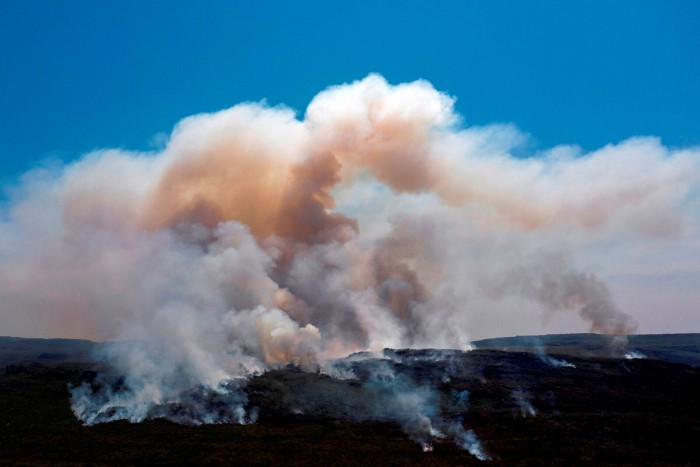
“It is of the utmost interest to the owners of the Estrondo estate to maintain the best possible relationship with the locals,” it said.
After a court decision granting 43,000 hectares to some 120 geraizeiro families was upheld in 2021, there are hopes for a final resolution.
Yet the dispute is not exclusive to Matopiba. While agricultural colonisation has brought development to this frontier zone of the Cerrado, in some cases it has also provoked conflicts over land and resources.
Fight over soyabeans
In a bid to halt further destruction of wild Cerrado, campaigners have focused on the commodity trading groups who act as a conduit for soyabeans to international markets.
Given their commercial power, these companies are the “key actors”, says Alex Wijeratna, campaign director at Mighty Earth, the advocacy group.
“They build the silos, they have a direct supply chain, they provide the port and crushing facilities and the ships,” he adds. “But their response is totally wanting.”
A collection of NGOs, European food companies, retailers and investors previously sought to convince traders to stop sourcing soyabeans from Cerrado land cleared since 2020. But the idea was rejected.
Cargill, Bunge, Archer Daniel Midlands and Louis Dreyfus Company together accounted for 55.2 per cent of known Cerrado soyabean exports in 2018, according to supply chain data platform Trase.
All declined to be interviewed for this article. So too did Brazilian group Amaggi, Brazil’s largest grain and fibre company.
Each of these traders has adopted self-imposed deadlines to rid their supply chains of deforestation and native vegetation conversion by the end of the decade at the latest.
Cargill said in a statement that it was committed to “find lasting solutions for protecting forests and native vegetation in the Cerrado in ways that are economically viable for farmers”.
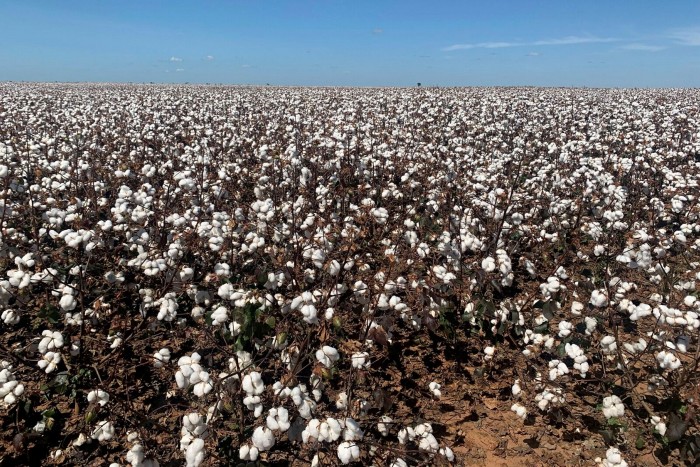
Bunge claimed to be the first company to foster large-scale efforts in the Cerrado “to track indirect purchases by sharing knowledge, methodologies and tools with resellers”.
ADM said: “Our goal is to build a more resilient and sustainable food system that protects forests, safeguards biodiversity, and supports communities.”
Under a collective initiative called the Soft Commodities Forum, six of the biggest traders have begun to disclose the proportion of soy that they source from the most affected areas of the Cerrado that is free of deforestation.
While activists say the responses do not go far enough, sector representatives counter that it is the legal right of landowners to deforest within the rules.
“This soy has a market,” says André Nassar, president of the Brazilian Association of Vegetable Oil Industries (Abiove), which represents traders. “We can guarantee it won’t go to the Europeans, but I can’t stop the farmer from producing.”
Abiove provides maps and data based on satellite imagery for its members to monitor farms and thereby meet their deforestation commitments.
The aim is to guarantee the “traceability” of Cerrado soyabeans — a feat likely to be harder for the roughly 30 per cent of indirect purchases through intermediaries such as local warehouses. “It’s a challenge, but it’s surmountable,” says Nassar, whose organisation is offering a traceability tool to such indirect suppliers.
Industry figures meanwhile claim that soy-driven conversion of native Cerrado vegetation has been steadily decreasing, pointing to analysis that only 9 per cent of new plantations between 2014 and 2021 were on deforested lands.
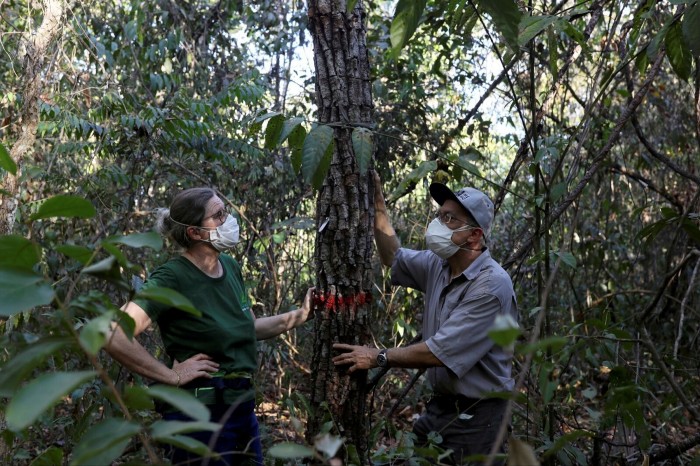
Yet sceptics argue the crop remains an indirect cause of Cerrado deforestation, due to its displacement of livestock grazing sites.
One idea that is taking off is the making of payments to farmers to preserve untouched areas of Cerrado voluntarily. Projects are also taking shape to offer financial incentives such as cheap credit in exchange for not deforesting, restoring degraded tracts, planting on old pastures and the sustainable intensification of beef ranching.
An initiative launched at last year’s UN climate summit in Glasgow has secured $4bn in commitments towards funding “deforestation and conversion-free” cattle and soy production in South America by 2025, backed by financial institutions and agribusiness groups.
The Innovative Finance for the Amazon, Cerrado and Chaco scheme has a goal for its signatories to release $200mn by the end of 2022.
Optimists believe a balance can be struck between feeding the world and saving the planet’s most biodiverse savannah.
“Brazil doesn’t need any further ecosystem destruction for reaching national targets of [agricultural] production increase in the coming decades,” argues Frederico Machado of WWF-Brasil. “There is plenty of already cleared or deforested lands that are suitable.”
Additional reporting by Carolina Ingizza in São Paulo
